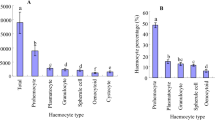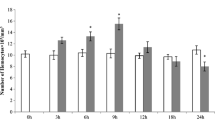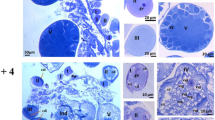Abstract
Hemocytes, cells present in the hemocoel, are involved in the immune response of arthropods challenged with entomopathogens. The present study established the best methodology for harvesting hemocytes from Rhipicephalus microplus and evaluated the number of hemocytes in addition to histological analysis from ovaries of fungus-infected females and tested the virulence of GFP-fungi transformants. Different centrifugation protocols were tested, and the one in which presented fewer disrupted cells and higher cell recovery was applied for evaluating the effect of Metarhizium spp. on hemocytes against R. microplus. After processing, protocol number 1 (i.e., hemolymph samples were centrifuged at 500×g for 3 min at 4 °C) was considered more efficient, with two isolates used (Metarhizium robertsii ARSEF 2575 and Metarhizium anisopliae ARSEF 549), both wild types and GFP, to assess their virulence. In the biological assays, the GFP-fungi were as virulent as wild types, showing no significant differences. Subsequently, hemocyte quantifications were performed after inoculation, which exhibited notable changes in the number of hemocytes, reducing by approximately 80% in females previously treated with Metarhizium isolates in comparison to non-treated females. Complementarily, 48 h after inoculation, in which hemolymph could not be obtained, histological analysis showed the high competence of these fungi to colonize ovary from ticks. Here, for the first time, the best protocol (i.e., very low cell disruption and high cell recovery) for R. microplus hemocyte obtaining was established aiming to guide directions to other studies that involves cellular responses from ticks to fungi infection.






Similar content being viewed by others
References
Alden L, Demoling F, Baath E (2001) Rapid method of determining factors limiting bacterial growth in soil. Appl Environ Microbiol 67:1830–1838
Alves SB (1998) Controle Microbiano de Insetos. FEALQ, Piracicaba
Alves FM, Bernardo CC, Paixão FRS, Barreto LP, Luz C, Humber RA, Fernandes EKK (2017) Heat-stressed Metarhizium anisopliae: viability (in vitro) and virulence (in vivo) assessments against the tick Rhipicephalus sanguineus. Parasitol Res 116:111–121. https://doi.org/10.1007/s00436-016-5267-z
Angelo IC, Fernandes EKK, Bahiense TC, Perinotto WMS, Moraes APR, Terra ALM, Bittencourt VREP (2010) Efficiency of Lecanicillium lecanii to control the tick Rhipicephalus microplus. Vet Parasitol 172:317–322. https://doi.org/10.1016/j.vetpar.2010.04.038
Bennett GF (1974) Oviposition of Boophilus microplus (Canestrini) (Acarida: Ixodidae) I. Influence of tick size on egg production. Acarologia 16:53–61
Bittencourt VREP, Massard CL, Lima AF (1992) Uso do fungo Metarhizium anisopliae (Metschnikoff, 1879) Sorokin, 1883, no controle do carrapato Boophilus microplus (Canestrini, 1887). Arq Univ Fed Rur Rio J 15:197–202
Brayner FA, Araujo HR, Santos SS, Cavalcanti MG, Alves LC, Souza JR, Peixoto CA (2007) Haemocyte population and ultrastructural changes during the immune response of the mosquito Culex quinquefasciatus to microfilariae of Wuchereria bancrofti. Med Vet Entomol 21:112–120. https://doi.org/10.1111/j.1365-2915.2007.00673.x
Bryant WB, Michael K (2014) Blood feeding induces hemocyte proliferation and activation in the African malaria mosquito, Anopheles gambiae Giles. J Exp Biol 217:1238–1245. https://doi.org/10.1242/jeb.094573
Camargo MG, Gôlo PS, Angelo IC, Perinotto WMS, Sa FA, Quinelato S, Bittencourt VREP (2012) Effect of oil-based formulations of acaripathogenic fungi to control Rhipicephalus microplus ticks under laboratory conditions. Vet Parasitol 188:140–147. https://doi.org/10.1016/j.vetpar.2012.03.012
Camargo MG, Nogueira MRS, Marciano AF, Perinotto WMS, Coutinho-Rodrigues CJB, Scott FB et al (2016) Metarhizium anisopliae for controlling Rhipicephalus microplus ticks under field conditions. Vet Parasitol 223:38–42. https://doi.org/10.1016/j.vetpar.2016.04.014
Carrillo D, Dunlap CA, Avery PB, Navarrete J, Duncan RE, Jackson MA et al (2015) Entomopathogenic fungi as biological control agents for the vector of the laurel wilt disease, the redbay ambrosia beetle, Xyleborus glabratus (Coleoptera: Curculionidae). Biol Control 81:44–50. https://doi.org/10.1016/j.biocontrol.2014.10.009
Castillo JC, Robertson AE, Strand MR (2006) Characterization of hemocytes from the mosquitoes Anopheles gambiae and Aedes aegypti. Insect Biochem Mol Bio 36:891–903. https://doi.org/10.1016/j.ibmb.2006.08.010
Castillo J, Brown MR, Strand MR (2011) Blood feeding and insulin-like peptide 3 stimulate proliferation of hemocytes in the mosquito Aedes aegypti. PLoS Pathog 7:e1002274. https://doi.org/10.1371/journal.ppat.1002274
Cheng W, Chen JC (2000) Effects of pH, temperature and salinity on immune parameters of the freshwater prawn Macrobrachium rosenbergii. Fish Shellfish Immunol 10:387–391. https://doi.org/10.1006/fsim.2000.0264
Clarke P, Mogg TV, Tvedten HW, Korcal D (2002) Artifactual changes in equine blood following storage, detected using the Advia 120 hematology analyzer. Vet Clin Pathol 31:90–94
Coggins SA, Estevez-Lao TY, Hillyer JF (2012) Increased survivorship following bacterial infection by the mosquito Aedes aegypti as compared to Anopheles gambiae correlates with increased transcriptional induction of antimicrobial peptides. Dev Comp Immunol 37:390–401. https://doi.org/10.1016/j.dci.2012.01.005
Dostert C, Jouanguy E, Irving P, Troxler L, Galiana-Arnoux D, Hetru C, Hoffmann JA, Imler JL (2005) The JakSTAT signaling pathway is required but not sufficient for the antiviral response of Drosophila. Nat Immunol 6:946–953. https://doi.org/10.1038/ni1237
Drummond RO, Gladney WJ, Whetstone TM, Ernst SE (1971) Laboratory testing of insecticides for control of the winter tick. J Econ Entomol 64:686–688
Dugrillon A, Eichler H, Kern S, Klüter H (2002) Autologous concentrated platelet-rich plasma (cPRP) for local application in bone regeneration. Int J Oral Maxillofac Surg 31:615–619. https://doi.org/10.1054/ijom.2002.0322
Erler F, Ates AO (2015) Potential of two entomopathogenic fungi, Beauveria bassiana and Metarhizium anisopliae (Coleoptera: Scarabaeidae), as biological control agents against the June beetle. J Insect Sci 15:44. https://doi.org/10.1093/jisesa/iev029
Faggio C, Arfuso F, Piccione G, Zumbo A, Fazio F (2014) Effect of three different anticoagulants and storage time on haematological parameters of Mugil cephalus (Linneaus, 1758). Turk J Fish Aquat Sci 14:615–621. https://doi.org/10.4194/1303-2712-v14_3_03
Fazio F, Satheeshkumar P, Senthil Kumar D, Faggio C, Piccione G (2012) A comparative study of haematological and blood chemistry of Indian and Italian Grey mullet (Mugil cephalus, Linneaus, 1758). HOAJ Biol 5:1–5. https://doi.org/10.7243/2050-0874-1-5
Feitosa APS, Alves LC, Chaves MM, Veras DL, Silva EM, Alianca ASS et al (2015) Hemocytes of Rhipicephalus sanguineus (Acari: Ixodidae): characterization, population abundance, and ultrastructural changes following challenge with Leishmania infantum. J Med Entomol 52:1–10. https://doi.org/10.1093/jme/tjv125
Fernandes EKK, Bittencourt VREP (2008) Entomopathogenic fungi against south American tick species. Exp Appl Acarol 46:71–93. https://doi.org/10.1007/s10493-008-9161-y
Ferraz VCM, Ferrigno CRA, Schmaedecke A (2007) Platelet concentration of platelet rich plasma from dog, obtained through three centrifugation speeds. Braz J Vet Res An Sci 44:435–440
Fischhoff IR, Keesing F, Ostfeld RS (2017) The tick biocontrol agent Metarhizium brunneum (= M. anisopliae) (strain F52) does not reduce non-target arthropods. PLoS One 12:1–15. https://doi.org/10.1371/journal.pone.0187675
Fogaça AC, Lorenzini DM, Kaku LM, Esteves E, Bulet P, Daffre S (2004) Cysteine-rich antimicrobial peptides of the cattle tick Boophilus microplus: isolation, structural characterization and tissue expression profile. Dev Comp Immunol 28:191–200. https://doi.org/10.1016/j.dci.2003.08.001
Freitas MC, Coutinho-Rodrigues CJB, Perinotto WMS, Nogueira MRS, Chagas TT, Marciano et al (2015) Quantificação de hemócitos de fêmeas ingurgitadas de Rhipicephalus microplus infectadas por Beauveria bassiana sl. Rev Bras Med Vet 37:63–70
Gillespie JP, Kanost MR, Trenczek T (1997) Biological mediators of insect immunity. Annl Rev Entomol 42:611–643. https://doi.org/10.1146/annurev.ento.42.1.611
Gonshor A (2002) Technique for producing platelet-rich plasma and platelet concentrate: background and process. Int J Periodontics Restorative Dent 22:547
Grisi L, Leite RC, Martins JRS, Barros ATM, Andreotti R, Cançado PD, Leon AAP et al (2014) Reassessment of the potencial economic impact of cattle parasites in Brazil. Rev Bras Parasitol Vet 23:150–156. https://doi.org/10.1590/S1984-29612014042
Gulati GL, Hyland LJ, Kocher W, Schwarting R (2002) Changes in automated complete blood cell count and differential leukocyte count results induced by storage of blood at room temperature. Arch Pathol Lab Med 126:336–342. https://doi.org/10.1043/0003-9985(2002)126<0336:CIACBC>2.0.CO;2
Habeeb SM, Abou El-Hag HA (2008) Ultrastructural changes in hemocyte cells of hard tick (Hyalomma dromedarii: Ixodidae): a model of Bacillus thuringiensis var. thuringiensis H14;-endotoxin mode of action. Am Eurasian J Agric Environ Sci 3:829–836
Hillyer JF, Schmidt SL, Fuchs JF, Boyle JP, Christensen BM (2005) Age-associated mortality in immune challenged mosquitoes (Aedes aegypti) correlates with a decrease in haemocyte numbers. Cell Microbiol 7:39–51. https://doi.org/10.1111/j.1462-5822.2004.00430.x
Hu G, St Leger RJ (2002) Field studies using a recombinant Mycoinsecticide (Metarhizium anisopliae) reveal that it is rhizosphere competent. Appl Environ Microbiol 68:6383–6387. https://doi.org/10.1128/AEM.68.12.6383-6387.2002
Johns R, Sonenshine DE, Hynes WL (1998) Control of bacterial infections in the hard tick Dermacentor variabilis (Acari: Ixodidae): evidence for the existence of antimicrobial proteins in tick hemolymph. J Med Entomol 35:458–464
Klaunig JE, Goldblatt PJ, Hinton DE, Lipsky MN, Chacko J, Trump BF (1981) Mouse liver cell culture. I. Hep. In Vitro 17:913–925
Konopka K, Pretzer E, Felgner PL, Düzgüneŝ N (1996) Human immunodeficiency virus type-1 (HIV-1) infection increases the sensitivity of macrophages and THP-1 cells to cytotoxicity by cationic liposomes. Biochim Biophys Acta 1312:186–196
Leemon DM, Jonsson NN (2008) Laboratory studies on Australian isolates of Metarhizium anisopliae as a biopesticide for the cattle tick Boophilus microplus. J Invertebr Pathol 97:40–49. https://doi.org/10.1016/j.jip.2007.07.006
Lemaitre B, Hoffmann J (2007) The host defense of Drosophila melanogaster. Annu Rev Immunol 25:697–743. https://doi.org/10.1146/annurev.immunol.25.022106.141615
Liu W, Xie Y, Xue J, Gao Y, Zhang Y, Zhang X, Tan J (2009) Histopathological changes of Ceroplastes japonicus infected by Lecanicillium lecanii. J Invertebr Pathol 101:96–105
Maia L, Souza MV, Júnior JIR, Oliveira AC, Alves GES, Benjamin LA (2009) Platelet-rich plasma in the treatment of induced tendinopathy in horses: histologic evaluation. J Equine Vet Sci 29:618–626. https://doi.org/10.1016/j.jevs.2009.07.001
Marmaras VJ, Lampropoulou M (2009) Regulators and signalling in insect haemocyte immunity. Cell Sign 21:186–195. https://doi.org/10.1016/j.cellsig.2008.08.014
Marx RE (2001) Platelet-rich plasma (PRP): what is PRP and what is not PRP? Imp Dentistry 10:225–228
Ment D, Churchill ACL, Glazer I, Rehner SA, Rot A, Donzelli BGG, Samish M (2012) Resistant ticks inhibit Metarhizium infection prior to haemocoel invasion by reducing fungal viability on the cuticle surface. Environ Microbiol 14:1570–1583. https://doi.org/10.1111/j.1462-2920.2012.02747.x
Mohammadyani M, Karimi J, Taheri P, Sadeghi H, Zare R (2016) Entomopathogenic fungi as promising biocontrol agents for the rosaceous longhorn beetle, Osphranteria coerulescens. BioControl 6:579–590. https://doi.org/10.1007/s10526-016-9745-0
Nappi AJ (1974) Insect hemocytes and the problem of host recognition of foreignness. Contemp Top Immunol 4:207–224
Nation JL (2016) Insect physiology and biochemistry. University of Florida, Gainesville
Ojeda-Chi MM, Rodriguez-Vivas RI, Galindo-Velasco E, Lezama-Gutierrrez R (2010) Laboratory and field evaluation of Metarhizium anisopliae (Deuteromycotina: Hyphomycetes) for the control of Rhipicephalus microplus (Acari: Ixodidae) in the Mexican tropics. Vet Parasitol 170:348–354. https://doi.org/10.1016/j.vetpar.2010.02.022
Perinotto WMS, Angelo IC, Golo PS, Camargo MG, Quinelato S, Sa FA et al (2017) In vitro pathogenicity of different Metarhizium anisopliae s.l. isolates in oil formulations against Rhipicephalus microplus. Biocontrol Sci Technol 27:338–347. https://doi.org/10.1080/09583157.2017.1289151
Putter JS, Seghatchian J (2017) Cumulative erythrocyte damage in blood storage and relevance to massive transfusions: selective insights into serial morphological and biochemical findings. Blood Transfus 15:348–356. https://doi.org/10.2450/2017.0312-16
Roberts DW, St. Leger RJ (2004) Metarhizium spp., cosmopolitan insect pathogenic fungi: mycological aspects. Adv Appl Microbiol 54:1–70. https://doi.org/10.1016/S0065-2164(04)54001-7
Rot A, Gindin G, Ment D, Mishoutchenko A, Glazer I, Samish M (2013) On-host control of the brown dog tick Rhipicephalus sanguineus Latreille (Acari: Ixodidae) by Metarhizium brunneum (Hypocreales: Clavicipitaceae). Vet Parasitol 193:229–237. https://doi.org/10.1016/j.vetpar.2012.11.020
Samish M, Rehacek J (1999) Pathogens and predators of ticks and their potential in biological control. Annu Rev Entomol 44:159–182. https://doi.org/10.1146/annurev.ento.44.1.159
Samish M, Rot A, Ment D, Barel S, Glazer I, Gindin G (2014) Efficacy of the entomopathogenic fungus Metarhizium brunneum in controlling the tick Rhipicephalus annulatus under field conditions. Vet Parasitol 206:258–266. https://doi.org/10.1016/j.vetpar.2014.10.019
Sampaio IBM (2002) Estatística Aplicada à Experimentação Animal FEPMVZ. Horizonte, Belo
Sanchez-Roblero R, Huerta G, Valle J, Gomez J, Toledo J (2012) Effect of Beauveria bassiana on the ovarian development and reproductive potential of Anastrepha ludens (Diptera: Tephritidae). Biocontrol Sci Technol 22:1045–1091. https://doi.org/10.1080/09583157.2012.713090
Schank A, Vainstein MH (2010) Metarhizium anisopliae s.l. enzymes and toxins. Toxicon 56:1267–1274. https://doi.org/10.1016/j.toxicon.2010.03.008
Schawartz JL, Patterson GH (2003) Development and use of fluorescent protein markers in living cells. Science 300:87–91. https://doi.org/10.1126/science.1082520
Shimomura O (2005) The discovery of aquorin and green fluorescent protein. J Microsc 217:3–15. https://doi.org/10.1111/j.0022-2720.2005.01441.x/full
Silva SB, Savastano G, Bittencourt VREP (2006) Tipos celulares envolvidos na resposta imune de fêmeas de Boophilus microplus inoculados com Metarhizium anisopliae e Penicillium sp. Rev Bras Med Vet 15:128–131
Spellig T, Bottin A, Kahmann R (1996) Green fluorescent protein (GFP) as a new vital marker in the phytopathogenic fungus Ustilago maydis. Mol Gen Genet 252:503–509
Sterba J, Dupejova J, Fiser M, Vancova M, Grubhoffer L (2011) Fibrinogen-related proteins in ixodid ticks. Parasit Vectors 4:127. https://doi.org/10.1186/1756-3305-4-127
Stoepler TM, Castillo JC, Lill JT, Eleftherianos I (2013) Hemocyte density increases with developmental stage in an immune-challenged forest caterpillar. PLoS One 8:e70978. https://doi.org/10.1371/journal.pone.0070978
Wang C, St. Leger RJ (2006) A collagenous protective coat enables Metarhizium anisopliae to evade insect immune responses. Proc Natl Acad Sci 103:6647–6652. https://doi.org/10.1073/pnas.0601951103
Acknowledgments
We thank Coordenacão de Aperfeiçoamento de Pessoal de Nível Superior (CAPES), Fundação Carlos Chagas Filho de Amparo à Pesquisa do Estado do Rio de Janeiro (FAPERJ), and Conselho Nacional de Desenvolvimento Científico e Tecnológico (CNPq) from Brazil. We thank Dr. Diva Denelle Spadacci Morena (Butantan Institute, Sao Paulo, Brazil) for helping with the histological studies and Dr. Donald Roberts (Utah State University, Utah, USA) for providing the fungal isolates previously supplied by Dr. Raymond St. Leger (University of Maryland). Vania R.E.P. Bittencourt is a CNPq researcher.
Author information
Authors and Affiliations
Corresponding author
Ethics declarations
The experiment was part of a project approved by the Ethics Committee (CEUA no. 113/2014).
Conflict of interest
The authors declare that they have no conflict of interest.
Additional information
Section Editor: Boris R. Krasnov
Rights and permissions
About this article
Cite this article
de Paulo, J.F., Camargo, M.G., Coutinho-Rodrigues, C.J.B. et al. Rhipicephalus microplus infected by Metarhizium: unveiling hemocyte quantification, GFP-fungi virulence, and ovary infection. Parasitol Res 117, 1847–1856 (2018). https://doi.org/10.1007/s00436-018-5874-y
Received:
Accepted:
Published:
Issue Date:
DOI: https://doi.org/10.1007/s00436-018-5874-y




